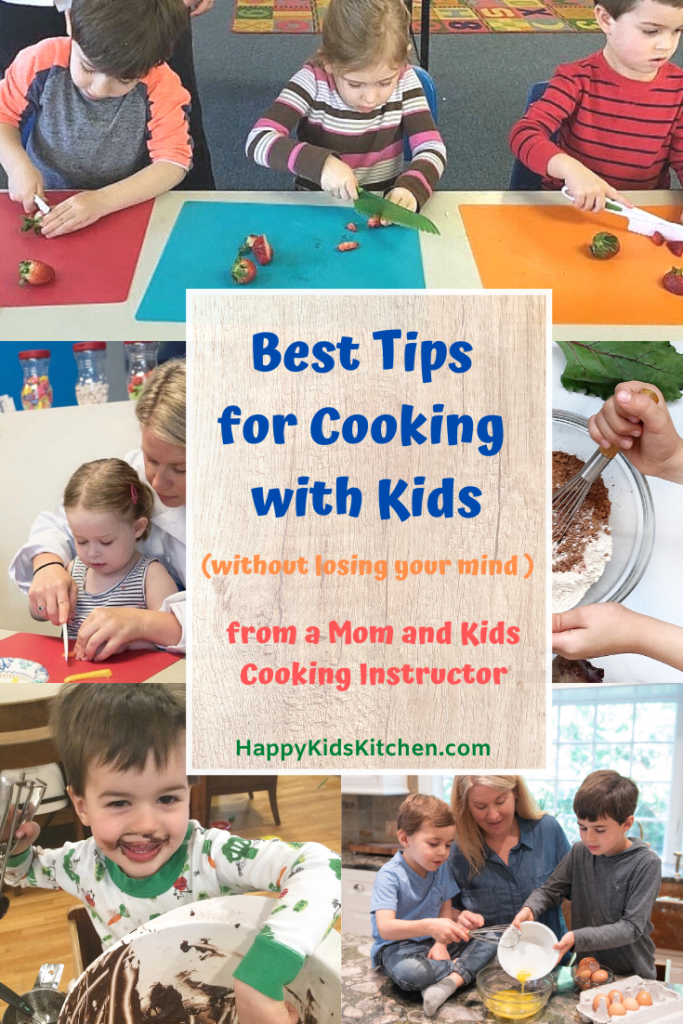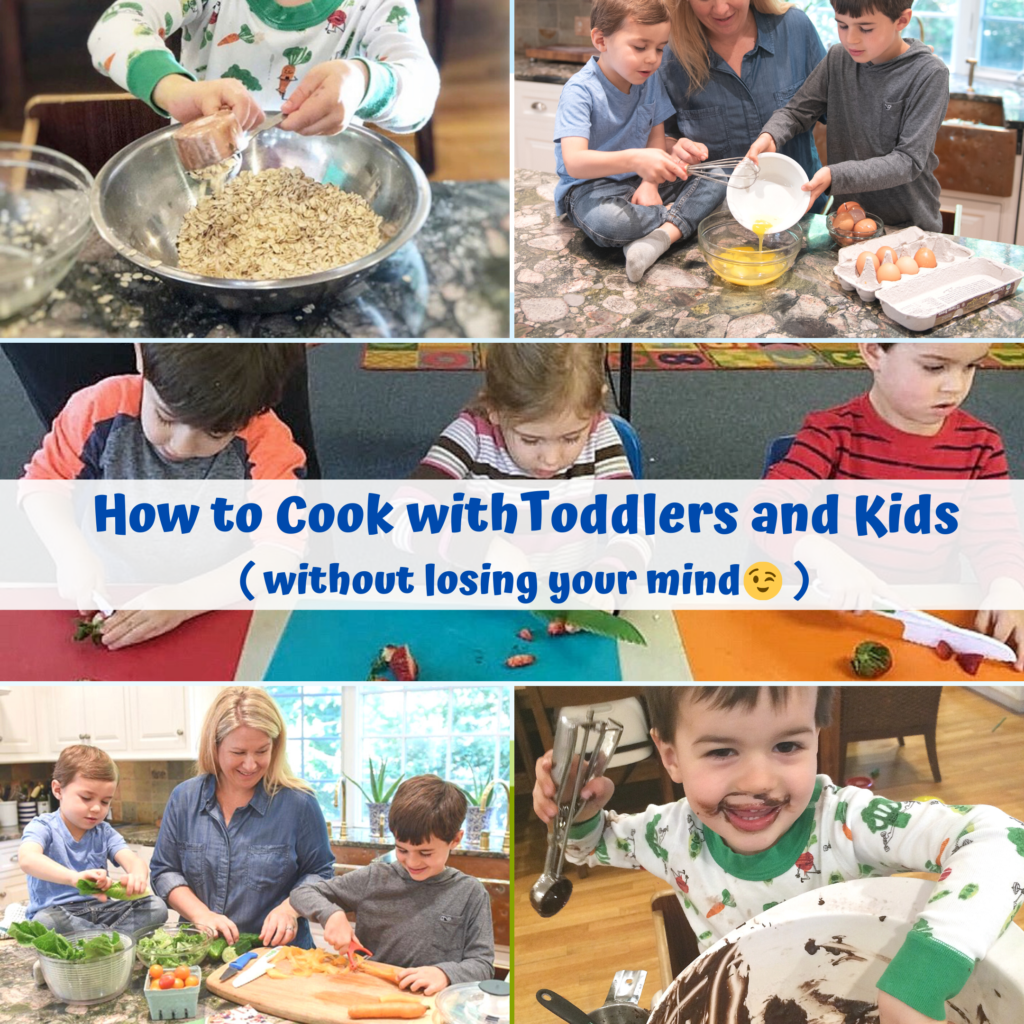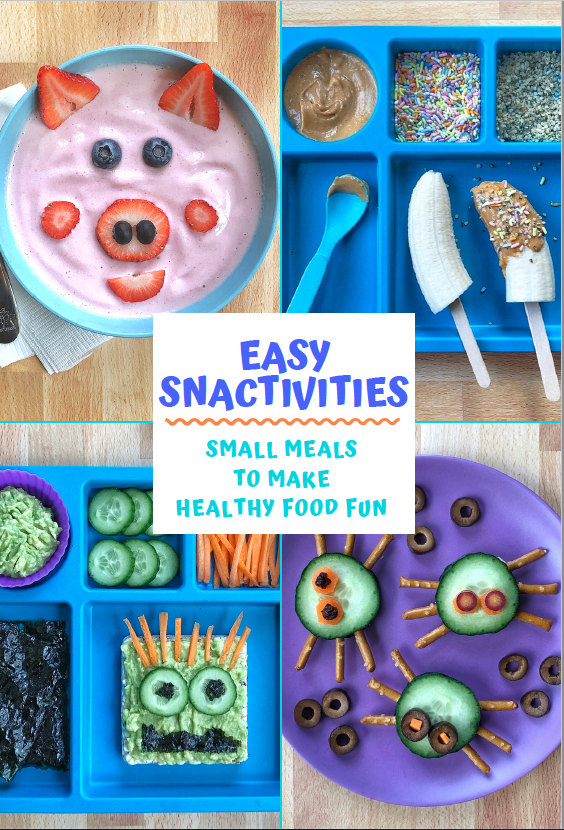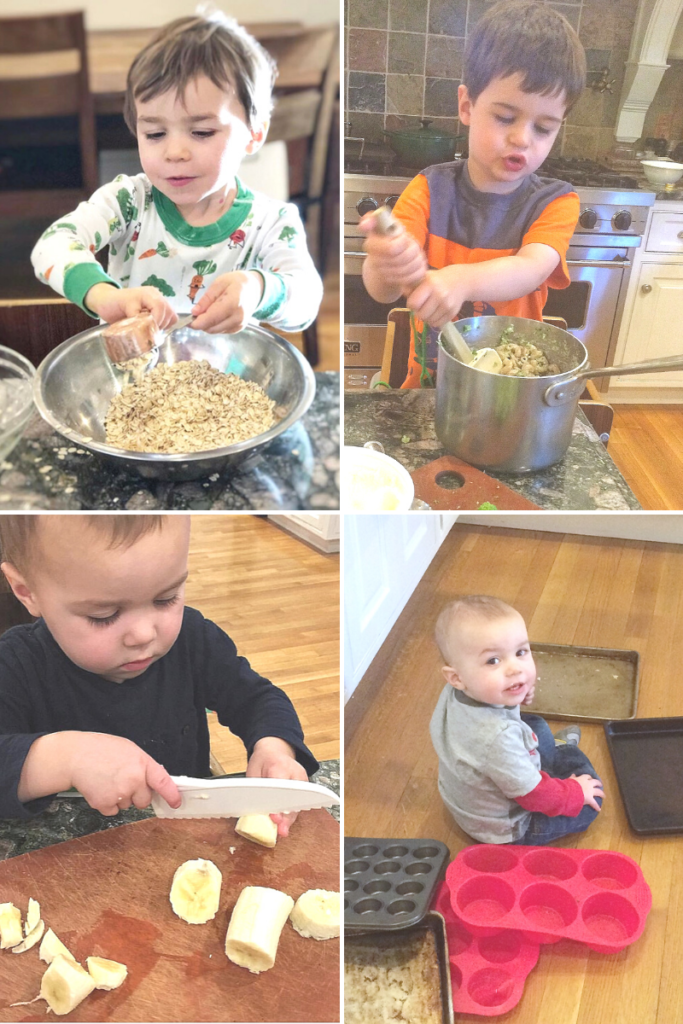Top 10 Tips for Cooking with Toddlers and Kids
You want to cook with your kids but the mess and chaos are holding you back? Teaching kids to cook takes extra time and extra patience. I get it! I’ve been teaching toddlers and young kids for over 12 years and when it comes time to get into the kitchen with my own children I still find it challenging. As parents, we are busy, cleaning all the time, and trying to fit too many things into one day. However, I’ve seen first hand, in my classes and at home, the beautiful things that happen when kids are encouraged to take ownership over their own food and play a part in preparing family meals.
Beyond being more likely to try new foods and eat a wider variety, children learn skills in the kitchen that they can rely on for the rest of their lives. I could go on about the reasons to get kids into the kitchen, but I want this article to do more than explain why cooking together is important and concentrate on things you can actually DO to make cooking with kids more enjoyable. Below, I’ve shared my Top 10 Tips for Cooking with Toddlers and Kids and under each category I’ve listed easy, actionable steps you can take to make your time in the kitchen more fun and less stressful.

A quick note: This post is one that may take a little time to read and digest. Save it to Pinterest (click the share buttons to the left) to look back on as a reference or to read again another time.
1. Start small, really small.
Kids don’t have to make an entire recipe with you to reap the benefits from being in the kitchen together. Have your child add one ingredient to the bowl, sprinkle a pinch of salt onto some veggies, or stir a couple ingredients together. Reframe “cooking with kids” as having children be a part of our lives in the kitchen, welcoming them into how we prepare meals and feed each other. The more you happily coexist in the kitchen together, the more comfortable you’ll be with having your child help with simple tasks and eventually spend longer times cooking together.
- Even starting as young as babies sitting in a highchair, narrate what you are doing while in the kitchen. Talk about what sounds you hear and what scents might be coming from what you’re cooking. “I just chopped some onions and added them in a hot pan. Can you hear the sizzle and start to smell the onions cooking?”
- See my IGTV video called “Chef Sprinkle” to see about my favorite 2-second way to get kids involved in making a meal. Hint: real cooking can simply start with a pinch of salt.
2. Encourage Play!
Making dinner but don’t have the time or patience to let your kiddo help? Happens to me all the time! Usually our kids are saying they want to be near us. It’s ok to say “not right now” to the actually cooking and set up an opportunity to play in the kitchen. Getting comfortable in the kitchen goes beyond handling real food and cooking utensils. We want our kids to feel like the kitchen is their space too (keeping safety in mind, of course). Allowing kids to handle ingredients, wash produce, or even simply play with toys within in the cooking area creates a connection. Here are some ideas for easy kitchen activities that might keep a little one busy while you prepare a meal:
- Peeling carrots? Give your child a small bowl full of peels to play with.
- Kiddo extra hungry while you’re prepping lunch? Try having him slice a banana or piece of cucumber with a kid-safe knife. See my blog post Teaching Knife Skills to Toddlers and Kids for a knife recommendation and more tips.
- Set up a “sensory activity” like a large bowl of oats or rice with some measuring cups and spoons to practice scooping and leveling. (This will most likely turn into a sweeping lesson later too.) Or have your child use play dough to make something pretend to eat.
- Bring play kitchen toys into the kitchen and have your child “cook” you something while you are preparing a meal. Ask questions about what she is making for you and how she is cooking it. Pretend to taste it and get excited about what your child has made you. This positive interaction during pretend cooking will lead to more “real” cooking together in the future.
3. It’s ok to lose your patience.
I do it too! The most important thing is to keep going, keep trying. Cooking together takes practice. Here are some ways I recover after having been less patient than I’d like:
- Explain why you might have lost your cool and use that as a teaching moment: “I raised my voice… that wasn’t nice of me. I’m really sorry. I was afraid that you were going to put too much baking powder into the cookies. The cookies will taste funny if we put too much in and I really want some yummy cookies for snack today, don’t you?”
- If your child is older, try going into detail more detail about why you overreacted: “Baking powder makes the cookies puff up and be lighter in texture. If we put too much in not only will the cookies taste funny, but they won’t rise properly.”
- Focus on the positive things you both do during your time in the kitchen and audibly compliment yourself and your child. You’ll both want to cook together more often if you concentrate on the fun you had in certain moments or the awesome cookies you made and shared with family.
4. Make recipes YOU want to eat.
There’s nothing more frustrating than spending time and energy cooking with your child and them refusing to eat what you’ve made together. Toddlers and young kids are fickle creatures. My son will eat three bowls of oatmeal one morning then refuse to eat any the next. Sound familiar? So, to avoid frustration and food waste choose recipes either you or other family members will most likely enjoy if your little one doesn’t. Your child does not have to eat what you cook to benefit from your time in the kitchen together! She is still learning, still being exposed to new textures, scents, and skills.
- Refer to my blog post 75 Best Recipes to Cook with Kids for some of my favorite recipes to make with little chefs.
- Choice: It’s a great idea to give a child a choice between two recipes but still make sure they are recipes you are excited about too.
5. Make up songs for simple tasks.
If singing isn’t your thing, totally feel free to skip this. However, humming a little tune or putting on your child’s favorite movie soundtrack, can really lighten the mood for both of you. Young children love music so make your time in the kitchen together more fun by singing together. This is especially affective when teaching kids skills that require patience like stirring slowly or taking turns.
- See my IGTV video called “The Sawing Song” for an example.
6. Feel comfortable with the recipe.
If you decide you have enough time to cook a full recipe with your child, make sure it’s not only a recipe you want to eat but it’s one you maybe have made before or made something similar. Read the entire recipe before you start. Then read it again. You’ll feel more confident and at ease about cooking in general (and especially with a crazy little one in tow) when you know what to anticipate and you’ve made sure you have equipment/ingredients you need.
- Print the recipe if using on online source or write down the ingredients and measurement on a piece of paper so screens or cookbooks will be less likely to fall victim to food splatters and spills. Older kids can help with this task and practice reading and writing skills by jotting the ingredients down.
7. Be VERY prepared!
There’s nothing worse than having to rummage through a drawer to find a measuring spoon while your toddler is at the counter with full access to a bag of flour and a container of salt. You know craziness can happen when you turn your back for a second, right? It’s definitely happened to me way too many times. So make sure to give yourself some time to get ready before your child even knows you’ll be cooking together. While your child is napping or occupied with something else, get out all the ingredients and equipment you’ll need. Here are some other ways I like to feel extra prepared when cooking with toddlers, especially:
- Think beyond the recipe: I like get out water bottles (someone always seems to get very thirsty while cooking), a healthy snack (if I don’t want my children eating all the recipe ingredients), and a few kitchen towels to wipe up messes and sticky hands.
- Measure some (or even all) of the ingredients ahead of time. This is especially helpful when baking and/or if you are cooking with a younger child that may have a shorter attention span. It’s great if your child just mixed and combines a few ingredients. For example, if making muffins, measure all the dry ingredients into one bowl and all the wet ingredients into another. Have you child help whisk the ingredients in each bowl with a whisk, dump one bowl into the other, then mix.
8. Take a break.
It’s totally normal for young kids to lose interest at any point during the cooking experience. Either put the recipe on pause, if you can, or keep going by yourself. Most likely your child will gain interest again and join you again or come in and out of helping. Embrace whatever this looks like for your child. And again, remember to make recipes/dishes you want to make and/or already intended to cook on your own. Here are a few ways to help kids that may lose interest in cooking easily:
- Take the pressure off and tell your child that he doesn’t have to cook for longer than he wants to. This will help some children feel more relaxed and less anxious about a new activity.
- Don’t put too much pressure on yourself. We can get really excited about cooking with our kids only to be sadly disappointed when they ditch us after two minutes (can you tell this has happened to me a time or two? haha). Keep your expectations low but keep trying. This is also why I suggest having your child help with meals/recipes you’re making for family meals. That way your child can help with a small task, such as peeling a carrot or adding ingredients to a bowl, and you’ll keep going even if your child loses interest.
9. Garnish!
Garnish is a “chefy” word that I love to teach to kids. It means to decorate or embellish the top of a dish or plate of food before serving/eating. Garnish sounds fancy but it can be as simple as adding sprinkles on top of a smoothie or ripping some basil over soup. Encouraging children to customize their own snacks or meals is an easy way for them to feel a sense of ownership and control over what they eat. This independence is key in creating positive and healthy relationships with food.
- Keep choices simple: “Would you like to add blueberries or strawberries on top of your oatmeal?” “Can you sprinkle this cheese onto our pasta for dinner? It will make it extra yummy!”
- Check out my free Ebook, Easy Snacktivities, for 8 healthy snack recipes that are designed specifically for kids to customize.
10. Embrace the mess…at least a little.
Sorry, guys, but I have to end this list with a little tough love. Cooking is messy. There’s no way to completely avoid it. Kids learn so much from exploring new sensations and there are so many to experience when cooking. Review the advice above and remember, you don’t have to go “all in” and bake a layer cake with your toddler. Start small, enjoy the crazy ride, and learn together. Wiping down the counter and sweeping the floor after will be worth it. I promise.

Hi, Thanks for reading!! I would LOVE your honest feedback. Did I miss anything you were hoping to read or learn about in this article? Do you feel it was helpful or lacking in depth? Is there a certain topic I included that you’d like me to explain more. Leave a comment below or mail me anytime! heather@happykidskitchen.com
Grab my free ebook, Easy Snacktivities, with 8 simple, healthy recipes that help little chefs get creative with food. See some examples in the picture below. Click HERE to download it now!



My 2 Boys would rather run off and play legos. I have a hard time keeping them interested in the kitchen.
Hi Mary, thanks so much for bringing this up. It’s so common. Not all kids are going to be interested in cooking and that’s ok. Start by making them feel a part of what you are doing in the kitchen. Maybe bring some legos into the kitchen while you make dinner and talk to your boys about what you’re doing. Sometimes ask them for help in a pressure free way like, “I’m so excited to make these muffins. I am cracking the eggs, do you think you could add this cup of oats to the bowl? That would be so helpful!” Maybe find ways to incorporate activities or things they really enjoy eating into a cooking project. Have them make more decisions about what they eat or what you have for dinner. Look at cookbooks for their input on recipes you make or YouTube videos of other kids cooking. Mostly, it is important to show your own enthusiasm about food. Show that you care about what you and your family eat and where it comes from. I think eventually those values “rub off” and kids become more interested in how their food is served/made. I could go on about this forever so please let me know if you have any other questions or specific situations you’d like me to expand on. xo heather
This list is great! I think #1 and #4 are both really helpful to feel less overwhelmed for just getting started. #2, 3, 8, and 10 are always good reminders, too.
I’d add to #7 that being prepared in our case has been helped by judicious additions of kid-friendly tools, like a kitchen helper, kid-safe knives…I LOVE the Curious Chef Children’s 2-Cup Clear Measuring Cup for helping reduce spills when pouring but also not worrying about shattering if it gets dropped! Or things like silicone muffin cup liners that reduce the amount of dishes to do after and create a good task for my toddler to help with in putting the liners into each cup in the tray.
I have also felt a lot more comfortable once I learned about using sous vide to pasteurize raw eggs. We still practice good hygiene in the kitchen but it just takes some pressure off in case there’s some finger sucking after egg cracking that I’m not quite quick enough to prevent, especially with wanting to avoid having to go to a doctor’s office in these pandemic days.
An amazing article this is, thank you so much for sharing these amazing tips with us will surely keep in mind and also share this with friends and family as well.
So glad it was helpful! Thank you.
Great tips, Heather! Thanks for sharing!
Thank you for the tips! There are so many benefits of letting kids help cook with you. Both of my kids are little and I decided to start allowing them to help me cook so they can learn good habits.https://www.ez.insure/landing/2018/10/benefits-of-cooking-with-kids/ was a great article that helped explain the benefits. It is a great read, which led me to research different tips to use and stumbles upon your blog! So thank you, I will be using it tonight!
Oh awesome! I’m so glad you found the post and are investing time into cooking with your kids! I share lots more on my Instagram page too Please reach out if you have any questions! 🙂 Heather
This is awesome and useful post. Most of the children participate sometimes. Proper kitchen tools is not for the children. This post explains how to participate with the toddle kitchen tools. This is very useful . Thank you for the post.
Hi Karen! So glad the post was helpful. Thank you! 🙂 Heather
Heather,
Thank you for the tips! There are so many benefits of letting kids help cook with you. You will be happy to know that I have loved cooking for a long time. I love to cook, especially if it’s for my family. I agree with you about helping kids cook. I allowed them to help with the cooking so that they could learn good things. There is a love in it because everyone in the family is involved with it. Will anyone provide an expert opinion on what age children should be involved in cooking?
Great article. Thank you! 👌🏻👌🏻👌🏻
I’m often alone with my toddler making dinner. I find that starting very early, say 4.30, is very helpful for both of us. I don’t get stressed out and end we both end up seeing it as an afternoon play session. He usually ends up ‘washing the dishes’ aka playing with water, while I finish. 😳But it’s so much more fun than him constantly trying to coax me out of the kitchen in tears.
HI! So glad the article was helpful! Love how you get your toddler involved in everyday cooking. Message me anytime. 🙂 Heather
My 2 year old son loves the Sesame Street segment called Monster Foodies, that has Cookie Monster and Gonger cook easy meals in their food truck. So up until now, I had him pretend to mix ingredients with a whisk and plastic bowl. However, with your article, I dared to get him more involved in cooking with me and so far we have made pizza and pancakes together! He loved rolling out the dough (with my help) and sprinkling the cheese for the pizza. He also did so good at mixing the ingredients for the pancakes. We made a mess but it was fun and delicious! Thanks for the inspiration and recipe suggestions!
Hi Ali, That means so much! I’m so happy to hear you and your son have been cooking and can’t wait to see what great chefs you both become together. Thanks you so much for taking the time to leave this message. 🙂 Heather
Great post! Don`t forget to give an apron to your kid. Have you seen these models https://www.cargocrew.com.au/aprons/collections/kids/ ?
Heya.
I use a list of tasks in order to make things simpler. For example when making biscuits this is what I do. I get one person to tidy up, another does the washing up and drying. A third person is responsible for decorating and so on. If we are making cakes for tea, this is what I do. One of us is in charge of cleaning up. Another does carry out other tasks.
[…] and preparing meals that are nutritious and enjoyable. Educating children about healthy eating and involving them in cooking can foster an appreciation for good nutrition. A balanced diet, rich in essential nutrients, […]